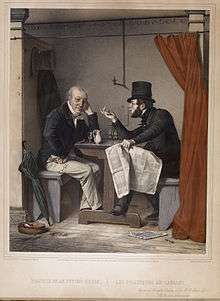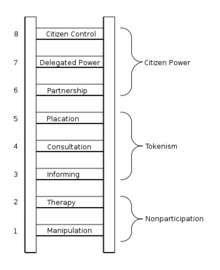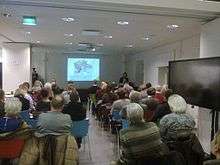Public participation (decision making)
Participation in social science refers to different mechanisms for the public to express opinions – and ideally exert influence – regarding political, economic, management or other social decisions. Participatory decision-making can take place along any realm of human social activity, including economic (i.e. participatory economics), political (i.e. participatory democracy or parpolity), management (i.e. participatory management), cultural (i.e. polyculturalism) or familial (i.e. feminism).

For well-informed participation to occur, it is argued that some version of transparency, e.g. radical transparency, is necessary but not sufficient. It has also been argued that those most affected by a decision should have the most say while those that are least affected should have the least say in a topic.
Objectives of participation
Participation activities may be motivated from an administrative perspective or a citizen perspective on a governmental, corporate or social level. From the administrative viewpoint, participation can build public support for activities. It can educate the public about an agency's activities. It can also facilitate useful information exchange regarding local conditions. Furthermore, participation is often legally mandated. From the citizen viewpoint, participation enables individuals and groups to influence agency decisions in a representational manner. The different types of political participation depends on the motivation. When a group is determined to work to solve a community problem, there can be led marches to work for candidates. Most immigrant racial groups have higher motivation since there is an increase in geographical dispersion and are faster growing racial groups.[1] How well participation can influence the relation between citizen and their local government, how it increases trust and boosts peoples willingness to participate Giovanni Allegretti explains in an interview using the example of participatory budgeting.[2]
Classifying participation

Sherry Arnstein discusses eight types of participation in A Ladder of Citizen Participation (1969). Often termed as "Arnstein's ladder", these are broadly categorized as:
- Citizen Power: Citizen Control, Delegated Power, Partnership.
- Tokenism: Placation, Consultation, Informing.
- Non-participation: Therapy, Manipulation.
She defines citizen participation as the redistribution of power that enables the have-not citizens, presently excluded from the political and economic processes, to be deliberately included in the future.[3]
Robert Silverman expanded on Arnstein's ladder of citizen participation with the introduction of his "citizen participation continuum." In this extension to Arstein's work he takes the groups that drive participation into consideration and the forms of participation they pursue. Consequently, Silverman's continuum distinguishes between grassroots participation and instrumental participation.[4]
Archon Fung presents another classification of participation based on three key questions: Who is allowed to participate, and are they representative of the population? What is the method of communication or decision-making? And how much influence or authority is granted to the participation?[5]
Other "ladders" of participation have been presented by D.M. Connor,[6] Wiedemann and Femers,[7] A. Dorcey et al.,[8] Jules N. Pretty[9] and E.M. Rocha.[10]
The International Association for Public Participation (IAP2) has developed a 'spectrum of public participation' based on five levels: information, consultation, involvement, collaboration and empowerment.[11]
Critiques of participation
Efforts to promote public participation have been widely critiqued. There is particular concern regarding the potential capture of the public into the sphere of influence of governance stakeholders, leaving communities frustrated by public participation initiatives, marginalized and ignored.[12]
Specific participation activities

Civic opportunity gap
Youth participation in civic activities has been found to be linked to a student's race, academic track, and their school's socioeconomic status.[13] The American Political Science Task Force on Inequality and American Democracy has found that those with higher socioeconomic status participate at higher rates than those with lower status.[14] A collection of surveys on student participation in 2008 found that "Students who are more academically successful or white and those with parents of higher socioeconomic status receive more classroom-based civic learning opportunities."[13] Youth from disadvantaged backgrounds are less likely to report participation in school-based service or service-learning than other students.[15][16] Students with more highly educated parents and higher household incomes are more likely to have the opportunity to participate in student government, give a speech, or develop debating skills in school.[17]
Corporate participation
Participation in the corporate sector has been studied as a way to improve business related processes starting from productivity to employee satisfaction.[18][19]
Participatory decision-making in science
Public participation in decision-making has been studied as a way to align value judgements and risk trade-offs with public values and attitudes about acceptable risk. This research is of interest for emerging areas of science, including controversial technologies and new applications.[20]
In the United States, studies have demonstrated public support for increased participation in science. While public trust in scientists remains generally high in the United States, [21] the public may rate scientists’ ability to make decisions on behalf of society less highly. For example, a 2016-2017 survey of public opinion on CRISPR gene editing technology showed a “relatively broad consensus among all groups in support of the idea that the scientific community ‘should consult with the public before applying gene editing to humans,’” providing a “broad mandate for public engagement.” [22]
The scientific community has struggled to involve the public in scientific decision-making. Abuses of scientific research participants, including well-known examples like the Tuskegee syphilis experiment, may continue to erode trust in scientists among vulnerable populations.
Additionally, past efforts to come to scientific consensus on controversial issues have excluded the public, and as a result narrowed the scope of technological risks considered. For example, at the 1975 Asilomar conference on recombinant DNA, scientists addressed the risks of biological contamination during laboratory experiments, but failed to consider the more varied public concerns that would surface with commercial adoption of genetically-modified crops.[23]
Researchers acknowledge that further infrastructure and investment is needed to facilitate effective participatory decision-making in science. A five-part approach has been suggested:
- Support effective science communication and engagement
- Capitalize on the strength of diverse coalitions
- Build capacity to deal with moving targets
- Focus on shared values
- Build trusting relationships through applied research and feedback loops [22]
Cross cultural objective participation
A cultural variation of participation can be seen through the actions of Indigenous American Cultures. Participation draws from two aspects: respect and commitment to their community and family. The respect is seen through their participation in non-obligated participation in various aspects of their lives, ranging from housework to fieldwork.[24]
Often the participation in these communities is a social interaction occurring as a progression for the community, rather than that of the individual. Participation in these communities can serve as a "learning service". This learning ranges from everyday activities, in which community members gain a new skill to complete a task or participate through social events to keep their cultural practices alive. These social participation events allow newer generations to see the events and learn from this ongoing participation to continue these practices.[25][26] Although there are different domains and objectives of participation in these communities, the bottom line to this participation is that it is non obligated and often community orientated.
A social interaction that continues to thrive because of this high level of non-obligation is the everyday action of translating.
See also
References
- Glass, J.J. (1979), "Citizen participation in planning: the relationship between objectives and techniques", Journal of the American Planning Association, 45 (2): 180–189, doi:10.1080/01944367908976956, PMID 10243958
- Eva-Maria Verfürth (February 2013). "More generous than you might think". dandc.eu.
- Arnstein, S.R. (1969), "A Ladder of Citizen Participation", Journal of the American Planning Association, 35 (4): 216–224, doi:10.1080/01944366908977225, hdl:11250/2444598, retrieved 2010-06-12
- Silverman R.M. (2005). "Caught in the middle: Community development corporations (CDCs) and the conflict between grassroots and instrumental forms of citizen participation". Community Development. 36 (2): 35–51. doi:10.1080/15575330509490174.
- Fung, A. (2006), "Varieties of Participation in Complex Governance" (PDF), Public Administration Review-Washington Dc-, 66: 66–75, doi:10.1111/j.1540-6210.2006.00667.x, archived from the original (PDF) on 2011-07-07, retrieved 2010-06-12
- Connor, D.M. (1988), "A new ladder of citizen participation", National Civic Review, 77 (3): 249–257, doi:10.1002/ncr.4100770309, archived from the original on 2012-10-20, retrieved 2010-06-12
- Wiedemann, P.M.; Femers, S. (1993), "Public Participation in waste management decision making: analysis and management of conflicts" (PDF), Journal of Hazardous Materials, 33 (3): 355–368, CiteSeerX 10.1.1.464.6934, doi:10.1016/0304-3894(93)85085-s, retrieved 2010-06-12
- Dorcey, A.; Doney, L.; Rueggeberg, H. (1994), "Public Involvement in government decision making: choosing the right model", BC Round Table on the Environment and the Economy, Victoria
- Pretty, Jules N. (1995). "Participatory Learning For Sustainable Agriculture". World Development. 23 (8): 1247–1263. doi:10.1016/0305-750x(95)00046-f.
- Rocha, E.M. (1997), "A ladder of empowerment", Journal of Planning Education and Research, 17 (1): 31–44, doi:10.1177/0739456x9701700104
- https://cdn.ymaws.com/www.iap2.org/resource/resmgr/Communications/A3_P2_Pillars_brochure.pdf
- O’Hare, Paul (March 2018). "Resisting the 'Long-Arm' of the State? Spheres of Capture and Opportunities for Autonomy in Community Governance: RESISTING THE 'LONG-ARM' OF THE STATE?" (PDF). International Journal of Urban and Regional Research. 42 (2): 210–225. doi:10.1111/1468-2427.12606.
- Kahne, Joseph & Middaugh, Ellen (2008), "Democracy for some: The civic opportunity gap in high school", Circle Working Paper, retrieved 2013-09-25
- APSA Task Force on Inequality and American Democracy (2004), "American Democracy in an Age of Rising Inequality", Perspectives on Politics, 2 (4): 651–666, doi:10.1017/s153759270404040x
- Spring, Dietz, and Grimm (2007), Leveling the Path to Participation: Volunteering and Civic Engagement Among Youth from Disadvantaged Circumstances, Corporation for National and Community ServiceCS1 maint: multiple names: authors list (link)
- Atkins, R. & Hart, D. (2003), "Neighborhoods, Adults, and the Development of Civic Identity in Urban Youth", Applied Developmental Science, 7 (3): 156–164, doi:10.1207/S1532480XADS0703_6
- Condon, M. (2007), "Practice Makes Participants: Developmental Roots of Political Engagement", Paper Presented at the Annual Meeting of the American Political Science Association
- Greenwood, M. (2007), "Stakeholder Engagement: Beyond the Myth of Corporate responsibility", Journal of Business Ethics, 74 (4): 315–327, doi:10.1007/s10551-007-9509-y
- Shetzer, L. (1993), "A social information processing model of Employee Participation", Organization Science, 4 (2): 252–268, doi:10.1287/orsc.4.2.252
- Christopherson, Scheufele, & Smith (2018), "The Civic Science Imperative", Stanford Social Innovation ReviewCS1 maint: multiple names: authors list (link)
- Hamilton, Eric (2019), Americans maintain high levels of trust in science, University Communications, University of Wisconsin-Madison
- Scheufele, Xenos, Howell, Rose, Brossard, & Hardy (2017), "U.S. attitudes on human genome editing", Science, 357 (6351): 553–554, doi:10.1126/science.aan3708, PMID 28798120CS1 maint: multiple names: authors list (link)
- JASANOFF, HURLBUT, & SAHA (2015), "CRISPR Democracy: Gene Editing and the Need for Inclusive Deliberation", Issues in Science and Technology, 32 (1)CS1 maint: multiple names: authors list (link)
- Coppens, Andrew (2014). "Children's initiative in contributions in family household work in Mexico". Human Development. 57 (2–3): 116–130. doi:10.1159/000356768.
- Rogoff, Barbara (2011). Developing destinies: A Mayan midwife and town. Cambridge: Oxford University Press. pp. 17–31.
- Hilger, Sister M. Inez (1951). "Chippewa child life and its cultural background". Smithsonian Institution, Bureau of American Ethnology. 146: 55–60, 114–117.
External links
- p-Government: Online participatory government
- Reed MS (2008) Stakeholder participation for environmental management: a literature review. Biological Conservation 141: 2417–2431 (for final published version see: https://web.archive.org/web/20110608090645/http://www.wiley.com/bw/journal.asp?ref=0888-8892)
- Participatory Economics Book Page (Participatory Decision Making)
- "Future in the Alps" Database with best practice examples of new forms of decision-making in the Alps
- "Participatory Learning and Action series" A leading informal journal on participatory learning and action approaches and methods, providing a forum for those engaged in participatory work - community workers, activists and researchers - to share their experiences, conceptual reflections and methodological innovations with others.
- "Participation and the FAO" The Participation Website was established in 1999 by the Informal Working Group on Participatory Approaches and Methods to Support Sustainable Livelihoods and Food Security (IWG-PA) from the Food and Agriculture Organization of the United Nations (FAO). The objective of the Participation Website is to bring together under one virtual roof, a broad cross-section of stakeholders interested in participatory approaches and methods in support of sustainable rural livelihoods and food security.
- "p-Government" The author proposes a new model of electronic governance based on the shared vision and collaboration of all the stakeholders. This new governance model shall be known as p-government or participatory government.
- Accountability and Participation Research with the focus on political participation by the GIGA - German Institute of Global and Area Studies]